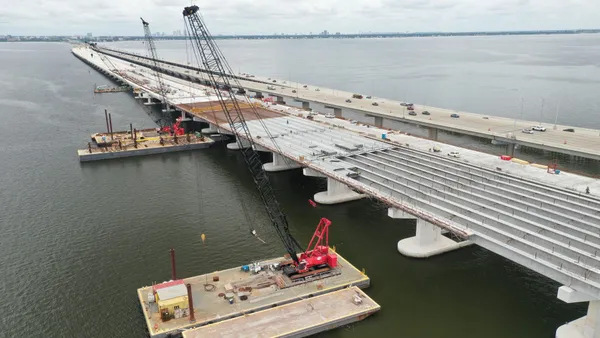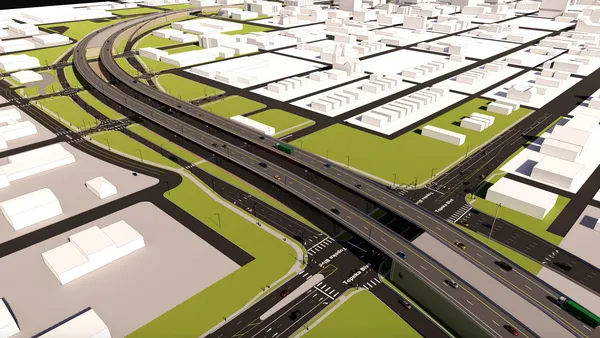UPDATE: Feb. 28, 2020: The Atlanta Regional Commission (ARC) Board has approved the updated transportation program in the Atlanta Regional Plan, which will see $172.6 billion — a mix of local, state and federal funding — go toward increasing mobility around the metro area through 2050. The ARC expects the population in the 20-county region to increase by 2.9 million people during the next 30 years to a total of 8.6 million.
The plan includes:
- $102 billion to upgrade and maintain existing infrastructure.
- $11 billion for an expansion of the metro's transit systems.
- $10 billion for congestion reduction programs that will reduce the number of automobiles on the road.
- $27 billion for interchange and highway improvements.
The commission expects transit ridership in the Atlanta metro area to more than double by 2050, which will reduce tailpipe emissions by more than 21 tons per year.
Dive Brief:
- The Atlanta Regional Commission (ARC) is readying a 2020 update to the metro area's Regional Transportation Plan (RTP) and is considering a $173 billion laundry list of projects to be completed during the next 30 years.
- Some of the spending in the draft RTP, according to ARC, includes $102 billion for maintenance of existing infrastructure — road resurfacing, bridge repair, replacement of old buses and rail cars and technology upgrades that will improve safety. Other projects in the draft RTP are light rail improvements to the city's MARTA system ($2.7 billion) and $10 billion for expansion of bike trails, the neighborhood-based Livable Centers Initiative and Transportation Demand Management Programs intended to help people change their travel behavior. By 2050, the RTP would add 600 lane miles of capacity to the region's network of roads and highways.
- The plan is not set in stone, and the ARC is encouraging members of the public to submit their thoughts about the draft. The public comment period runs through Dec. 13, but the public will also be able to give feedback on the plan at the next meeting of ARC's Transportation and Air Quality Committee, which is scheduled for Dec. 14.
Dive Insight:
To give some perspective about how much infrastructure costs, ARC noted that the Atlanta metro area will spend $33 billion of federal, state and local funds on such projects during the next six years alone.
Funding of the plan will come from a variety of sources. For instance, just the MARTA portion, $2.7 billion of a $3.9 billion, 40-year program will be paid for with 50% matching federal funds, as well as fare revenue and possibly private investment, transit-oriented developments and public-private partnerships (P3s). It's worth noting that MARTA officials arrived at the nearly $4 billion price tag after they whittled the potential project list down from $11 billion.
Projects performed in cooperation with the Georgia DOT will likely see some of them delivered as P3s, given the seeming enthusiasm some GDOT officials have for the method. At a recent Design-Build Institute of America conference, Darryl D. VanMeter, assistant P3 division director at the GDOT said the agency is involved in several P3s, such as the $800 million Interstate 285 project in Atlanta.
P3 partners, VanMeter told conference attendees, tend to be aligned with the DOT's mission to design, plan, build, operate and maintain the asset while considering its costs across the entire lifecycle. In fact, if the right teams get involved in the right projects, he said that P3s will "thrive" in the years to come.
Some public agencies have not realized the expected financial benefits from P3s, though. A study of Canadian P3s found that they were more expensive than traditional procurement methods, don't necessarily improve on highway safety, are redundant to the services that the government already provides and don't include a mechanism for public accountability.













